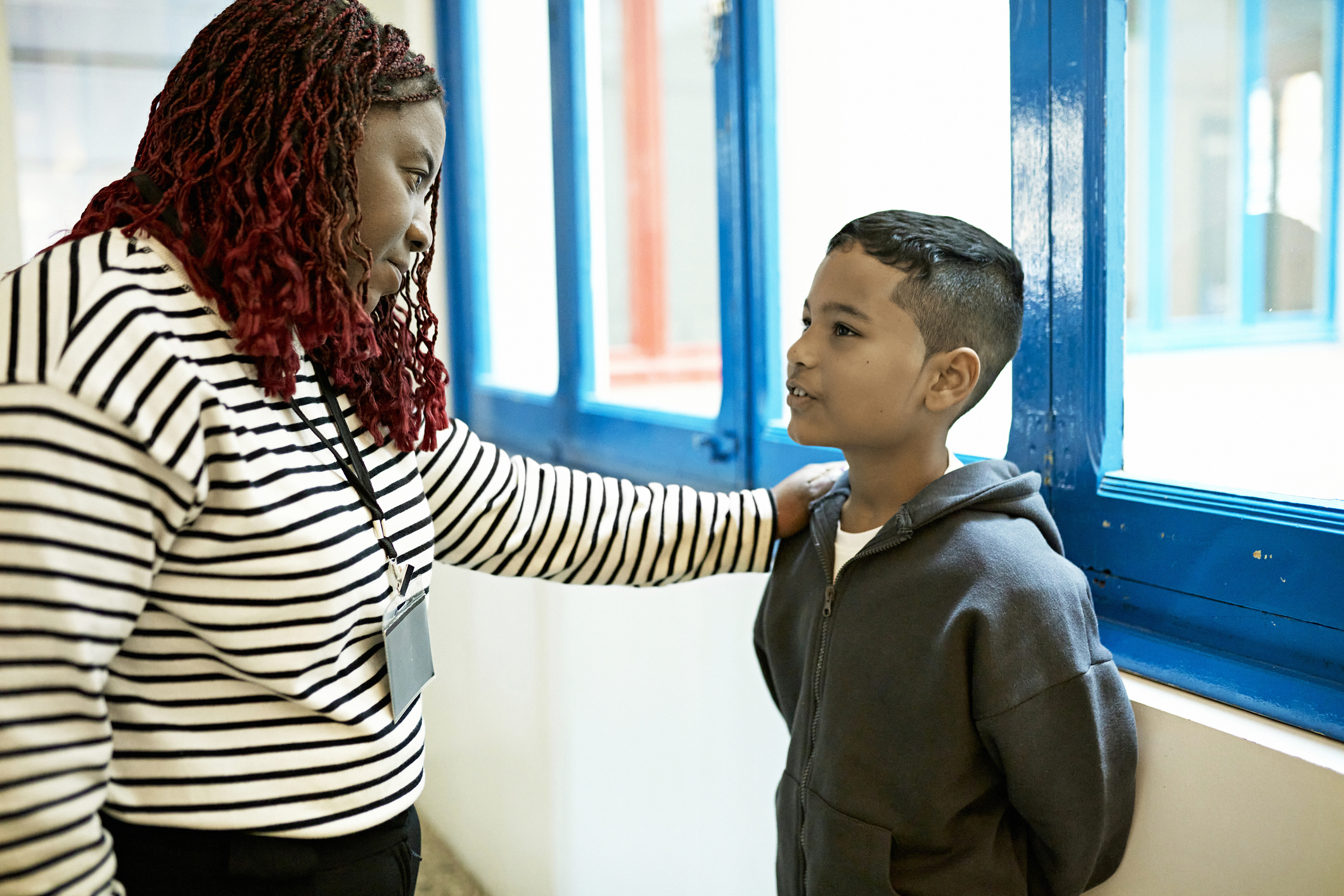Classroom management and disciplining
So let’s start first with the terminology. If you were asked to write a definition of classroom management, what would you write? Traditional classroom management often relates to agreeing or setting rules and having clear consequences when they are broken. Richards once described classroom management as the ways in which student behaviour, movement and interaction during a lesson are organised and controlled by the teacher. This very much reminds me of one of my teachers who raised their voice in class if we did not 100% behave, and then asked us to stay behind and recite poems as punishment!

Now, I’m not saying that we should throw-out rules – and making students stick to them – all together. Clear boundaries are essential because students need to know the limits and need to have clear expectations of what kind of behaviour we want to see in class. However, I also believe that rules will be more useful when co-constructed with our learners, e.g. in the form of a classroom contract so they feel more ownership and responsibility to stick to them.
The challenge for me is the word ‘management’ which implies that all the power is with us, that control should come from us and that when we lead our students simply follow! Not sure if anyone can relate to that! So, rather than viewing classroom management as a tool to discipline or control our learners I’d like to shift to a view of classroom management that is less about “ keeping order” and more reciprocal, all about “nurturing growth”. To use it as a developmental tool we first need to reframe our view of behaviour or rather misbehaviour.
Reframing behaviour
We often expect learners to behave – follow the rules – once rules and expectations have been made explicit. Whilst we agree that Rome wasn’t built in day and that learning a subject is a process, why do we not view behaviour as a learning process? I mean, we all have bad days (adults included…) and on those day even we may test each other’s boundaries, so how realistic is it to expect kids to follow all the rules perfectly all the time? Our learners are learning to manage life and test the boundaries with adults; it’s a natural part of their developmental process.
We also know that not all younger learners are at the same stage of development and able to follow rules easily, as I’m sure all parents know! Some learners may not have the skills yet or language to communicate what it is they need, which may result in behaviour that we regard as misbehaviour or undesired behaviour as I prefer to call it.
When we see behaviour as a way of communicating, we may be able to explore what particular need(s) they are trying to communicate with their undesired actions. Of course, we want to remind them that their actions are not within the expected behaviour but it is more beneficial for growth to ask them to think about their behaviour and their needs. This is where personal growth and social-emotional growth happens. Yes, it depends on what kind of behaviour is being displayed because dangerous behaviour indeed requires direct intervention and more of a management approach to keep everyone safe! When students ‘misbehave’ or act in puzzling ways that poses no danger to others or self, we can turn it into a learning opportunity by seeing their behaviour as a signal (less so than a problem) of them calling out for help: “Please see what I need and help me meet it in a more appropriate manner!”

So what needs might students be trying to communicate?
A needs-based approach to classroom management involves the belief that misbehaviour is usually a symptom of unmet needs and acknowledge that our learners bring a whole range of lived experiences into the classroom. It recognises that student behaviour is purposeful and rarely just a choice made in isolation simply to upset the teacher. Be aware that some of the needs they display in class could originate from students’ home context, the local community or beliefs and values common to their cultural context. Also, some student’s behaviours may be influenced by past experiences of trauma.
Maslow’s hierarchy of needs (1943), highlights the importance of meeting the needs of safety, belonging and self-esteem as essential for learning:
- Physiological; food, water
- Safety; physical and emotional
- Love and Belonging
- Esteem: achievement, respect
- Self-Actualization: realising one’s potential
Glasser (1998) also believed that all human behaviour, including classroom behaviour, is driven by the desire to get five basic needs met:
- Survival: physical safety and basic needs such as food, water
- Love and Belonging: supportive relationships, a sense of connection
- Power: Feeling competence, achievement and getting some recognition
- Freedom: having autonomy, choice and being able to be creative
- Fun: experiencing joy, learning through play and inviting curiosity
Both Maslow and Glasser emphasise the importance of meeting these basic needs within the classroom setting. Rather than resorting to a one-size-fits-all control strategy, teachers who adopt a more needs-based lens strive to consider these underlying needs in e.g. their lesson planning and interactions with learners by asking themselves the question: “How does this lesson, activity, or environment speak to one or more of these needs?” In other words, a needs-based approach can create a classroom culture where every student can feel seen, valued and experience a sense of belonging and agency.
Strategies for needs-based classroom management
1. Building Trust and Relationships
At the heart of a needs-focused classroom is the relationship between teachers and students. Build relationships by being genuinely interested in them, asking questions and getting to know them. Plan in for micro-interactions, take a few minutes here and there to share. If you have a large class, you could focus on 7×2: interact with 7 learners each day and try to engage with each of them for 2 minutes. Show empathy by being non-judgemental and asking questions. Trust is established when teachers take time to understand students’ background, interests and challenges. A sense of social-belonging and emotional security can lead to greater student participation and an opportunity to co-regulate behaviour: both can lead to improved performance and a reduction in undesired behaviour.

2. Creating a Positive, Inclusive Environment
A supportive physical and emotional learning environment is the foundation for student success. When students feel physically and psychologically safe, they are more likely to engage in positive behaviour. Giving them the permission to make mistakes and not having to be perfect is a great start, as well as encouraging and allowing them to be proud of their cultural identities, which enables culturally responsive teaching. Also, the language we use matters, so instead of saying “you were not listening” (judgement) we could say “ I noticed you were staring out of the window” (non-judgemental) and “can you tell me what you were thinking?” (exploratory), using a calm and kind voice. This approach shifts the conversation from judgement to reflection and highlights that classroom management in reciprocal.
3. Start with Empathy and Curiosity
Instead of labelling students and assuming that their behaviour is simply about defiance or inattention, approach each incident with curiosity. Be a needs-detective and ask yourself, “What need might this behaviour be expressing?” and “How can I best support this student in feeling ….?” This mindset not only prevents hasty judgments but also encourages us to think about what different students need. It helps us view undesired behaviour as a chance to learn more about our students and recognises their diverse learning preferences and abilities. Approaching student’s behaviour empathetically, without judgement but with curiosity and compassion, not only helps better meet students’ unique needs, but it also transforms those disruptive moments into opportunities for social-emotional growth and for learning to happen.

4. Integrating Social-Emotional Learning (SEL)
Social-emotional learning is critical for addressing students’ needs. Making SEL part of your daily teaching practice helps students develop skills such as self-awareness and self-regulation which are key for emotionally managed classrooms. By teaching these competences, we can facilitate uncovering possible underlying issues—whether they be related to past trauma, a need for attention or another unmet need- and empower students to become more self-aware of what it is they need. Stop thinking what is wrong with them and start asking “Can you tell me what you need right now?”. Strengthen their self -regulation skills by asking “What would be a better way to meet this need? or “How can I best support you with this …?”.
Final thoughts
Viewing classroom management through a needs lens means recognising that behaviour is often a signal of underlying needs that are unmet and shifts the focus to a more empathetic approach that promotes social and emotional growth. It moves our view from control to connection, from rules to relationships and from compliance to curiosity. Below are a few more reflective questions that might help you experiment with this approach:
• What emotion is driving their behaviour?
• What might this student need right now?
• How can I respond with curiosity, not control?
• What systems/routines/ activities can I create to meet these core needs?
By adopting some of the strategies mentioned above, we can turn classroom management from a daily struggle for power into a tool for fostering growth and academic success and better prepare students for the challenges of the future. But remember, there’s only one person’s behaviour you have got full control over in the classroom and that is yours! So, what about starting with exploring our teacher-needs and reflecting on how we express these in the classroom? Because desired behaviour all start with the behaviour we display and model!




